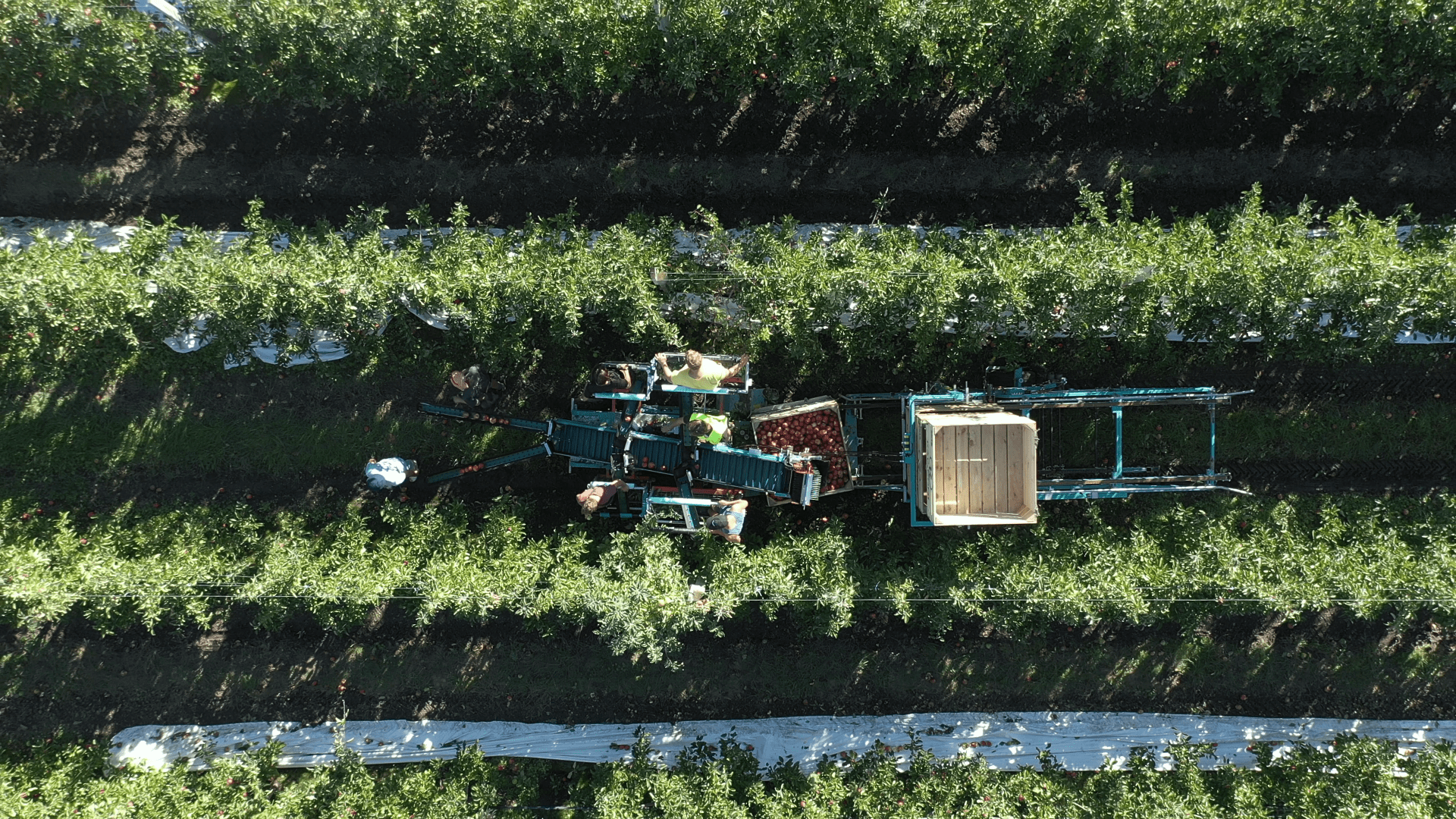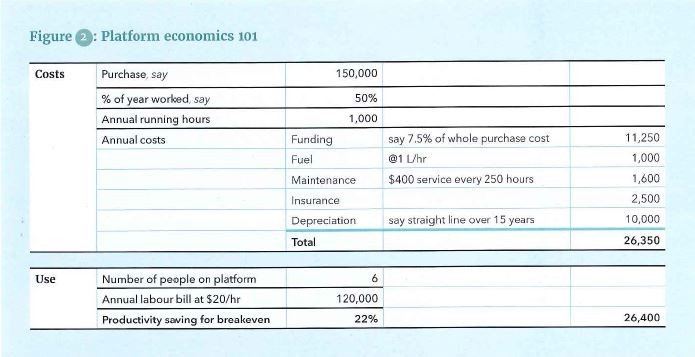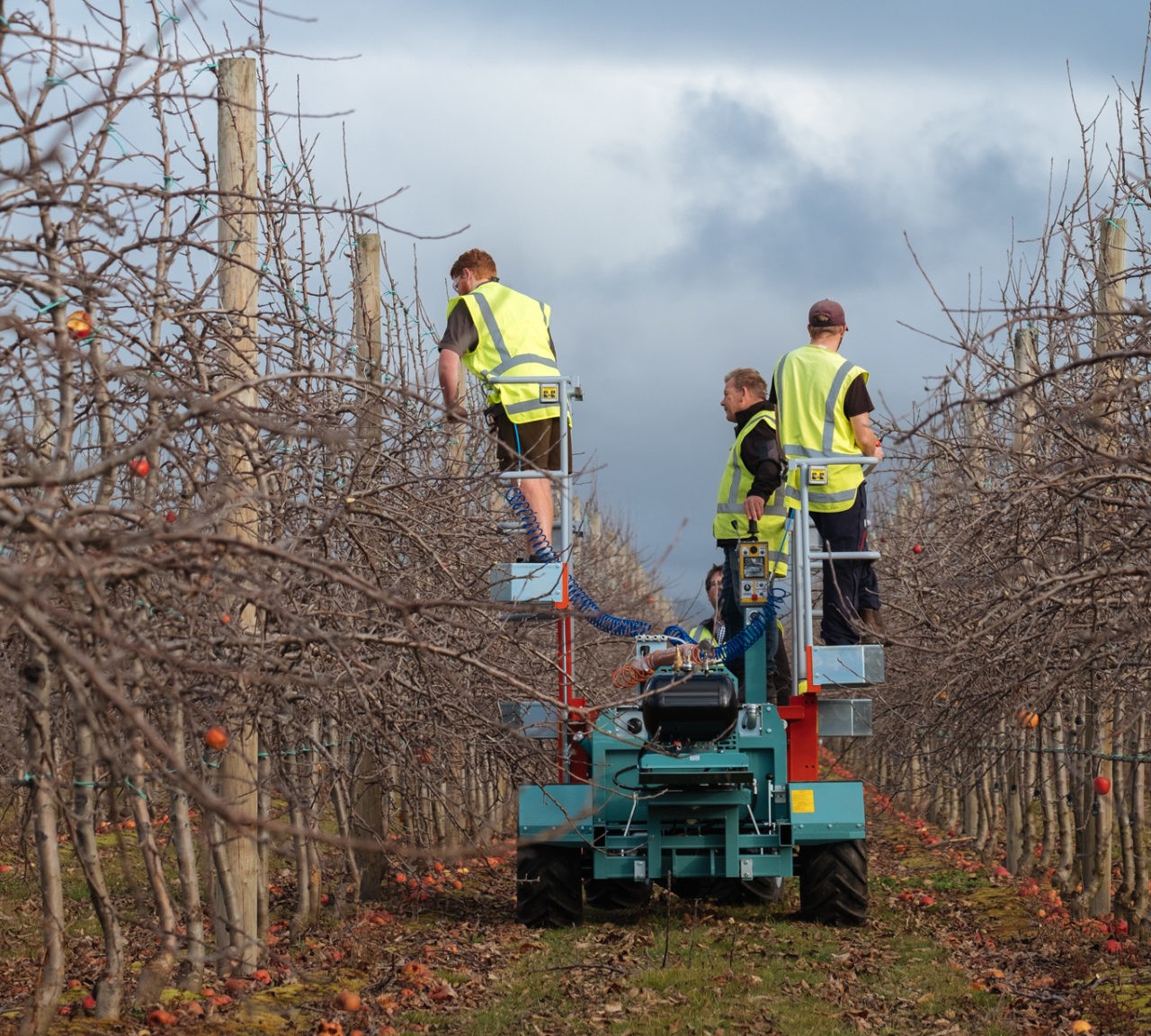Platform ready?
As first seen in the Orchardist, November 2020
Jack Hughes, Horticultural Consultant, Fruition , Hawke’s Bay
Media stories tend to give the impression to the ‘man in the street’ that the apple crop can be or soon will be picked by robots. The reality is that robots have yet to be commercially deployed and ‘robot ready’ fruiting canopies are yet to be perfected. What about the more readily achievable option of ‘platform ready’? In this article we take a big picture look at platforms rather than getting into the detail of equipment design, features or brands. Equally, nothing in the health and safety space will be covered.
Birds eye view of a Galaxy Tecnofruit platform picking apples
Ergonomically speaking
Let’s start by considering how suited platforms are to the apple orchard canopies that are currently out there? It’s a row width and canopy depth thing.
If the human arm has a comfortable reach of about 500mm, we’re limited to total canopy width of 1.0 metre given access from both sides. It follows that the range of accessible row widths is governed by the width of the machine at the narrow end of its spectrum through to the outer range that the worker platforms can be extended outwards for wider rows. There also needs to be an access and safety margin to avoid damage to people, trees and crop.
For example, a machine may be 1.8m wide and the worker cages may extend out to a maximum of 3.0m. If our total canopy depth is 1.0m, the range of usable row widths is 2.8m – 4.0m excluding any ‘breathing space’. Canopy uniformity is our friend here as the more uniform the canopy profile, the narrower the safety margin gap between platform and canopy can be.
A 200mm gap either side of the platform cage takes our maximum row width out to 4.4m. This range of row widths would include virtually all blocks planted in the last decade but probably a minority of older semi-intensive blocks.
The next question of how ‘platform ready’ are blocks with row widths of 4m or less? Most young plantings and those on trellised systems like 2D and twin stem will be, while most 3D plantings at row widths over 3.0m are likely to need adjustment. Their canopy width, especially at the bottom will probably exceed 1.0m.
Tree height
Tree heights have been reducing over time. Skyscraper 5+ metre high blocks are now a rarity and the majority of producing apple blocks are probably in the 4.0 – 4.5m height range. This exceeds the comfortable maximum reachable height from a platform of 3.5m. Yes, machine modifications can tweak that range up but stability will eventually be compromised.
Burning questions
A key question is whether canopies should be retro-fitted to make them more ‘platform suitable’? The concern being that removing the sides and tops of existing canopies might be removing the most productive bits. A temporary yield reduction might be ok but what if this was permanent?
We don’t have a lot of experience in New Zealand yet but there are positive signs and some overseas evidence to draw from. The introduction of cab tractors in New Zealand required the slimming down of upper canopies and this didn’t usually reduce yield, in fact it sometimes led to increases in quality crop.
Studies in upstate New York showed that 3D canopies could be successfully transitioned to platform compatible fruiting walls provided the retro-fitting was staged gradually over 3-4 years (Sazo, 2018). In these experiments, mechanical hedging was used to ‘set the box’. Later season timings were better because vegetative regrowth was less.
Canopy Geometry
Let’s explore a few numbers on canopy geometry. If canopy dimensions are set at 1m for top to bottom width and tree height is capped at 3.6m, we have a fixed rectangular ‘row end profile’. As orchard row width increases, canopy volume per hectare decreases because there’s more ‘fresh air’ in the row. Over a 2.8 – 5.0m row width range, canopy volume of a platform suitable canopy decreases from slightly over 10,000 m3 to a mere 6,000 cubes (Figure 1).
The opposite trend in canopy volume occurs with traditional 3D canopies because tree dimensions typically increase as wider rows allow more space for bigger trees. Figure 1 shows how change in canopy volume differs with increasing row width depending on which canopy management approach is taken. This data suggests that platform ready canopies will have to be more efficient than their 3D counterparts to hold their own in the yield department. At this early stage, we could expect that at row widths beyond 3.5m, there will be a ‘yield’ price for a platform compatible canopy.
Counter intuitive
The counter intuitive factor is that larger canopy volume doesn’t necessarily translate into higher yield. The killer examples may be planar cordon (FOPS) or 2D where canopy volumes are surprisingly small and reported yields are surprisingly high.
The Plant and Food designed planar cordon canopies are super slim (500-600mm total width) with very narrow rows (1.5-2.0m) to achieve efficient light interception and accumulate enough canopy per unit of area. Their published yield data which is north of 150 t/ha for these 9-10,000 m3 canopies says that canopy efficiency is more important than canopy volume. Recent new planar cordon plantings have been planted on 2.2m row widths. The goal is finding a sweet spot between enough space for conventional machinery without undue yield reduction from increased row width. By the way, I’m told that looking behind you is not a good idea when driving down these narrow rows.
The business case
What about the numbers, then? Can the purchase of a $150,000 platform be justified? Note that this ballpark price estimate includes platform, bin trailer, conveyers and a compressor. There are many differing estimates and opinions of the productivity gains on offer. Let’s take the approach of estimating the cost of ownership and operation and then calculating the productivity gains required to cover them (Figure 2). In this example, the big-ticket items of ownership are funding the purchase and allowing for depreciation. Running and overhead costs are relatively ‘small beer’.
Let’s assume that a platform operates for half the year (pruning, thinning picking and some block development work), so it is assisting 6 people for 1,000 hours. In this example, we require a 22% lift in worker productivity to cover the platform cost. Is this easily achieved? You be the judge.
There are, of course, other factors that are harder to quantify but no less important. Platforms enable a wider range of people to actually participate and this could make the different between getting the crop picked – on time or even at all in these Covid disrupted times.
Also, if the use of platforms increases packout by reducing handling damage and improving picker accuracy, the numbers are even more compelling. Think of a platform operating as a mini-picking gang. Over a 10-week season at 50 bins a day, a small increase in the export recovery of 2,500 bins of fruit adds up. Something like $7,500 for every percentage point rise in packout.
Galaxy Tecnofruit platform in action winter pruning apples
Conclusion
Fruitgrowing is becoming more capital intensive both in terms of growing systems and the gear to grow and handle the crop. This path looks set to continue as labour gets scarcer and more expensive. Platforms look likely to become more popular.
References: Mario Miranda Sazo (2018) New Advances to Narrower Canopy Systems: Transitioning from 3D to 2D Canopies or Fruiting Walls – Part 3. NY Fruit Quarterly Vol 26. No 1.



